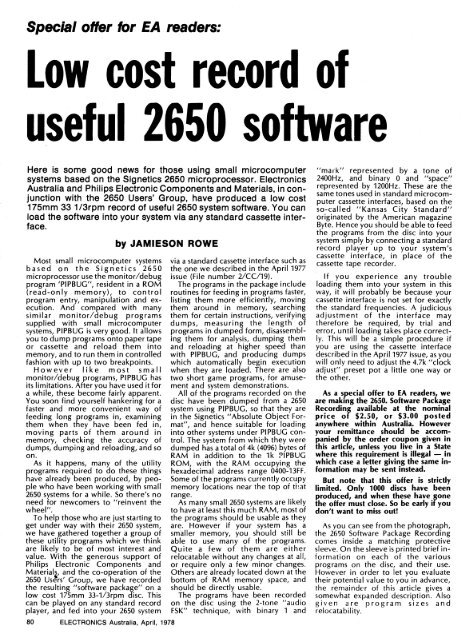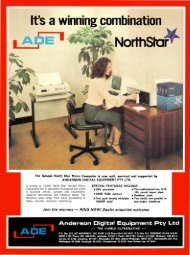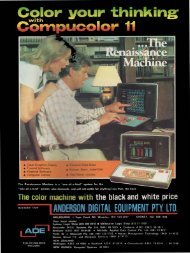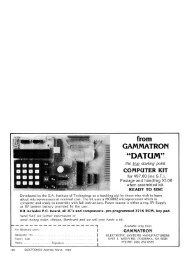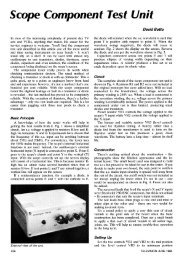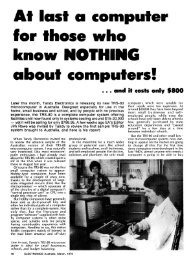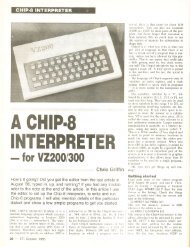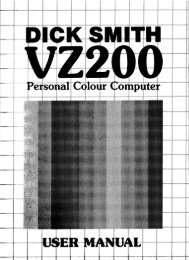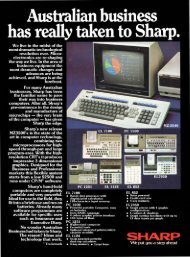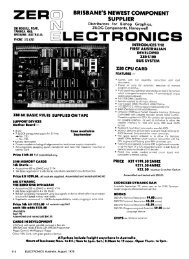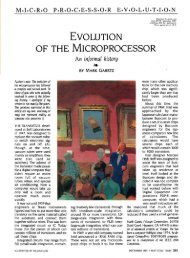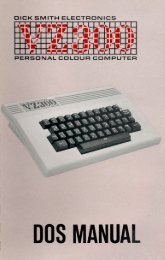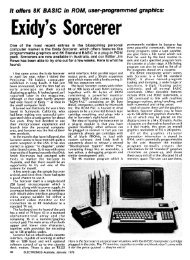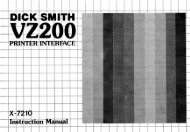The Signetics 2650 - The MESSUI Place
The Signetics 2650 - The MESSUI Place
The Signetics 2650 - The MESSUI Place
You also want an ePaper? Increase the reach of your titles
YUMPU automatically turns print PDFs into web optimized ePapers that Google loves.
Special offer for EA readers:<br />
Low cost record of<br />
useful <strong>2650</strong> software<br />
Here is some good news for those using small microcomputer<br />
systems based on the <strong>Signetics</strong> <strong>2650</strong> microprocessor. Electronics<br />
Australia and Philips Electronic Components and Materials, in conjunction<br />
with the <strong>2650</strong> Users' Group, have produced a low cost<br />
175mm 33 1/3rpm record of useful <strong>2650</strong> system software. You can<br />
load the software into your system via any standard cassette interface.<br />
Most small microcomputer systems<br />
based on the <strong>Signetics</strong> <strong>2650</strong><br />
microprocessor use the monitor/debug<br />
program `PIPBUG", resident in a ROM<br />
(read-only memory), to control<br />
program entry, manipulation and execution.<br />
And compared with many<br />
similar monitor/debug programs<br />
supplied with small microcomputer<br />
systems, PIPBUG is very good. It allows<br />
you to dump programs onto paper tape<br />
or cassette and reload them into<br />
memory, and to run them in controlled<br />
fashion with up to two breakpoints.<br />
However like most small<br />
monitor/debug programs, PIPBUG has<br />
its limitations. After you have used it for<br />
a while, these become fairly apparent.<br />
You soon find yourself hankering for a<br />
faster and more convenient way of<br />
feeding long programs in, examining<br />
them when they have been fed in<br />
moving parts of them around in<br />
memory, checking the accuracy of<br />
dumps, dumping and reloading, and so<br />
on.<br />
As it happens, many of the utility<br />
programs required to do these things<br />
have already been produced, by people<br />
who have been working with small<br />
<strong>2650</strong> systems for a while. So there's no<br />
need for newcomers to "reinvent the<br />
wheel".<br />
To help those who are just starting to<br />
get under way with their <strong>2650</strong> system,<br />
we have gathered together a group of<br />
these utility programs which we think<br />
are likely to be of most interest and<br />
value. With the generous support of<br />
Philips Electronic Components and<br />
Materialt, and the co-operation of the<br />
<strong>2650</strong> Users Group, we have recorded<br />
the resulting "software package" on a<br />
low cost 175mm 33-1/3rpm disc. This<br />
can be played on any standard record<br />
player, and fed into your <strong>2650</strong> system<br />
by JAMIESON ROWE<br />
80 ELECTRONICS Australia, April, 1978<br />
via a standard cassette interface such as<br />
the one we described in the April 1977<br />
issue (File number 2/CC/19).<br />
<strong>The</strong> programs in the package include<br />
routines for feeding in programs faster,<br />
listing them more efficiently, moving<br />
them around in memory, searching<br />
them for certain instructions, verifying<br />
dumps, measuring the length of<br />
programs in dumped form, disassembling<br />
them for analysis, dumping them<br />
and reloading at higher speed than<br />
with PIPBUG, and producing dumps<br />
which automatically begin execution<br />
when they are loaded. <strong>The</strong>re are also<br />
two short game programs, for amusement<br />
and system demonstrations.<br />
All of the programs recorded on the<br />
disc have been dumped from a <strong>2650</strong><br />
system using PIPBUG, so that they are<br />
in the <strong>Signetics</strong> "Absolute Object Format",<br />
and hence suitable for loading<br />
into other systems under PIPBUG control.<br />
<strong>The</strong> system from which they were<br />
dumped has a total of 4k (4096) bytes of<br />
RAM in addition to the 1k PIPBUG<br />
ROM, with the RAM occupying the<br />
hexadecimal address range 0400-13FF.<br />
Some of the programs currently occupy<br />
memory locations near the top of that<br />
range.<br />
As many small <strong>2650</strong> systems are likely<br />
to have at least this much RAM, most of<br />
the programs should be usable as they<br />
are. However if your system has a<br />
smaller memory, you should still be<br />
able to use many of the programs.<br />
Quite a few of them are either<br />
relocatable without any changes at all,<br />
or require only a few minor changes.<br />
Others are already located down at the<br />
bottom of RAM memory space, and<br />
should be directly usable.<br />
<strong>The</strong> programs have been recorded<br />
on the disc using the 2-tone "audio<br />
FSK" technique, with binary 1 and<br />
"mark" represented by a tone of<br />
2400Hz, and binary 0 and "space"<br />
represented by 1200Hz. <strong>The</strong>se are the<br />
same tones used in standard microcomputer<br />
cassette interfaces, based on the<br />
so-called "Kansas City Standard"<br />
originated by the American magazine<br />
Byte. Hence you should be able to feed<br />
the programs from the disc into your<br />
system simply by connecting a standard<br />
record player up to your system's<br />
cassette interface, in place of the<br />
cassette tape recorder.<br />
If you experience any trouble<br />
loading them into your system in this<br />
way, it will probably be because your<br />
cassette interface is not set for exactly<br />
the standard frequencies. A judicious<br />
adjustment of the interface may<br />
therefore be required, by trial and<br />
error, until loading takes place correctly.<br />
This will be a simple procedure if<br />
you are using the cassette interface<br />
described in the April 1977 issue, as you<br />
will only need to adjust the 4.7k "clock<br />
adjust" preset pot a little one way or<br />
the other.<br />
As a special offer to EA readers, we<br />
are making the <strong>2650</strong>. Software Package<br />
Recording available at the nominal<br />
price of $2.50, or $3.00 posted<br />
anywhere within Australia. However<br />
your remittance should be accompanied<br />
by the order coupon given in<br />
this article, unless you live in a State<br />
where this requirement is illegal — in<br />
which case a letter giving the same information<br />
may be sent instead.<br />
But note that this offer is strictly<br />
limited. Only 1000 discs have been<br />
produced, and when these have gone<br />
the offer must close. So be early if you<br />
don't want to miss out!<br />
As you can see from the photograph,<br />
the <strong>2650</strong> Software Package Recording<br />
comes inside a matching protective<br />
sleeve. On the sleeve is printed brief information<br />
on each of the various<br />
programs on the disc, and their use.<br />
However in order to let you evaluate<br />
their potential value to you in advance,<br />
the remainder of this article gives a<br />
somewhat expanded description. Also<br />
given are program sizes and<br />
relocatability.


